Post by E_Wing on Jul 15, 2010 16:33:02 GMT 8
Kit: XXXG-00W0 Wing Gundam Zero (EW Version) (Gunpla 30th Anniversary Clear Parts Campaign Vol. 1 Part 2)
Scale: 1:100
Grade: Master Grade
MG #: 75 (original release)
Series: Shin Kidō Senki Gundam Wing: Endless Waltz (New Mobile Report Gundam Wing: Endless Waltz)
Release date(s):
Original release: October 2004
Clear Parts Campaign Ver.: December 18, 2009
Price: ¥3,990 (both versions; inclusive of tax)
Number of Parts:
Original kit: 319 plastic parts (297 actual parts (151 Polystyrene (PS) + 108 Acrylonitrile butadiene styrene (ABS) + 14 Thermoplastic elastomer (TPE) + 24 Polyethylene (PE)) + 22 unneeded parts) + 1 sheet foil stickers + 1 sheet marking seal + 1 sheet dry-transfer decals
Additional clear parts: 41 clear Polystyrene (PS)
Total Number of Runners: 16 + 1
Polycap Number: PC-126
Plastic Colors: White, Blue, Red, Yellow, Gray, Clear, Clear Green, Black
Weapons and Accessories: Twin buster rifle x1, Beam saber x2, Adjustable stand x1
Kit Gimmicks: internal frame, variable wing design, replication of the mech's various poses as seen in the OVA/movie, compatibility with all variants of Bandai's Action Base 1 (including the clear green and fluorescent green Celestial Being stand) and the stands released with the first production of certain NG 1:100 Gundam SEED Destiny and MG kits, extra clear armor set
HISTORY:
Kit History:
After the release of the much-anticipated MG Wing Gundam Ver. Ka in March 2004, many fans and modelers speculate that in the near future an MG Wing Gundam Zero (EW ver., also known as Wing Gundam Zero Custom to avoid confusion with the TV version), considering that the two are basically the same except for the wings, weapon systems, and the color scheme. Surely enough, it was announced later that the MG version of the Wing Gundam Zero will be released in the near future, together with an optional base stand, just like the MG Ex-S and Aile Strike kits that preceded it. This kit is also notable for starting the trend of releasing a non-Ver. Ka kit based on the Ver. Ka kit itself.
Mecha History:
After designing and (unfinished) building the OZ-00MS Tallgeese, the XXXG-00W0 Wing Gundam Zero was the first mobile suit designed (but not built) by the five former OZ (Organization of Zodiac) scientists (which will build their own Gundam units later based on this mech to be used in Operation Meteor: Doctor J (Wing; from the orbiting colony cluster at Lagrangian point 1), Professor G (Deathscythe; Lagrangian point 2), Doktor S (Heavyarms; Lagrangian point 3), Instructor H (Sandrock; Lagrangian point 4), and Master O (Shenlong; Lagrangian point 5))) to be composed of Gundanium Alloy (a rare and extremely durable metal that can only be created in outer space) as its main armor composition. It was not built due to the MS' two destructive distincts: its twin buster rifle, which can destroy a whole colony in a single shot, and its ZERO System, a cockpit-pilot interface system that directly interfaces the pilot's brain and feeds the pilot real-time tactical data. After sometime on, a grieving Quatre Raberba Winner (pilot of XXXG-01SR Gundam Sandrock) over his father's murder at the hands of OZ's soldiers, stumbled at the blueprints of the Wing Zero and decided to build it using his family's resources as his replacement Gundam. As he first used it, he was severely affected by the unit's ZERO System, causing him to become mentally imbalanced and therefore went on a rampage against OZ and the colonies to avenge his father's death, destroying a natural resource satellite (in other words, an asteroid with incorporated mining facilities) and an evacuated space colony (Colony 06E3) in the process. He was later stopped by Trowa Barton and Heero Yuy, while piloting the OZ-13MSX1 Vayeate and OZ-13MSX2 Mercurius respectively.
Later the unit is taken into possession by OZ and tested its ZERO System (using Heero and (later) Duo Maxwell as test pilots; both were driven mad similar to Quatre due to the system) in hopes that the unit will be incorporated to their line of mobile suits until the Romefeller Foundation's (OZ's parent army) Mobile Doll Chief Engineer Tuberoff sees the Gundam as a threat to his Mobile Dolls and orders his men to have the unit planted with explosives and be destroyed. As his men were evacuating prior to the detonation of the explosives, Zechs Merquise stumbles the Gundam and claimed it, sacrificing his Tallgeese in the process. With Zechs piloting the unit, he then later on encounters Heero with his ZERO System-equipped OZ-13MS Gundam Epyon, built by the Treize Faction leader Treize Khushrenada. They later switched units after their battle during the dissolution of Relena Peacecraft's Sanc Kingdom. This unit remained as Heero's personal unit with his battle with Zechs (now known by his original name Milliardo Peacecraft) and his Gundam Epyon (except in two instances wherein he lend his unit with Trowa and Chang Wufei to solve their respective problems, becoming the only Gundam unit to be used by all five original pilots) during the first Eve War, and later destroyed the last fragment of the Peacemillion-class space battleship Libra during atmospheric entry. After the war, it is stored at the Lunar Base along with the other Gundams with Howard (the co-designer of the Tallgeese and the co-creator of the first Peacemillion-class ship Peacemillion) as its custodian and caretaker until the Gundams (with the exception of Wufei's) are sent to the sun via an abandoned resource satellite for destruction.
Later, due to the war with Dekim Barton's Barton Foundation against the Earth Sphere Unified Nation (ESUN), including with Relena's kidnapping, Heero retrieves the Wing Zero via a special booster system connected to the feet and wings from the satellite thanks from Quatre and his Maganac Corps allies. He later confronted Wufei on Earth orbit and continued their fight after their re-entry in the Earth's atmosphere until the Wing Zero was defeated. The Wing Zero was last seen firing its combined twin buster rifle at the Barton Foundation's Brusell Fortress three times until the fortress' bunker shield and the Wing Zero was destroyed (at the latter's case, due to the effect of the rifle's recoil on a damaged Gundam frame).
PRELIMINARY REVIEW
Box art
Front:
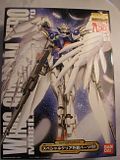
Standard Bandai-style art, depicting the kit in the usual CG form like in other Gundam kits. The MG and the anime logo, as well as the Gunpla 30th Anniversary logo are present at the top right of the box, with the Bandai logo at the lower right of the box. The Clear Parts Campaign logo is at the lower center portion of the box together with the production date (2009 instead of 2004 since this is a special release) at the lower left. The upper box itself measures 32.96cm in height and 24.07cm in length, which is the same for the MG Wing Ver. Ka.
North/South Side:
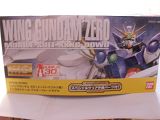
The art for the north and south side of the box is the same: a simplified version of the front box art, but with a yellow band at the bottom, which seems to indicate what Clear Parts Campaign volume the kit belongs to. The width/depth of the box measures 12.21cm long.
Left Side:
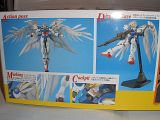

The left side of the box shows the kit's action poses, the kit's markings, the cockpit, the kit as mounted on its display base/stand, and the kit with the exclusive clear parts attached on one side.
Right Side:
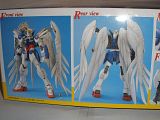
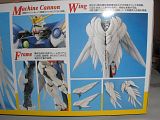
The right side of the box features the (typical) front and rear view of the mech (with the painted pilot figure), the opening gimmick of the machine cannons, the internal leg frame, and the wing detail.
Inner cover:
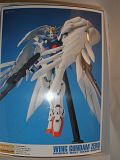
The box's inner cover features the completed kit itself with the stand attached replicating the pose as shown at the box itself. This kit is the second-to-the-last kit to feature an inner cover (before MG #77 RMS-099 Rick Dias Quattro Bagina Custom) aside from the Ver. Ka and OYW kits. The MG logo is also shown at the lower left edge of the cover.
Inner box:
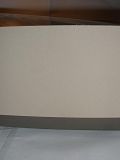
The inner box features a gray stripe at the lower edge, similar to the first-production release of certain NG 1:100 Gundam SEED Destiny kits (the one with the exclusive stands). This stripe indicates that there are additional parts not present in the regular release version, and the width of the stripe indicates the total width of the added sprues.
Underneath the box:
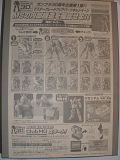
Underneath the kit's box shows the 22 selected MG kits to be released with the exclusive clear parts as part of the campaign's Volume 1 release. The order of release for these kits are different from Ngeekhiong's initial announcement. The box also shows how to “register” the kit to the Club MG website to earn points for use on the Club-specific items.
Kit contents:
Runners:
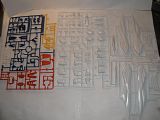
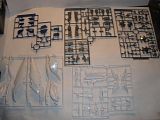
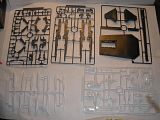
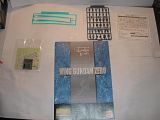
The kit contains a total of 319 parts crammed in 16 runners (all labeled A-L in usual Bandai style, with the (reusable) beam saber parts labeled as SB4). Some of the runners are basically the same with the MG Wing Ver. Ka, while the other nine runners are brand-new. Runner D has its color changed from white to blue.
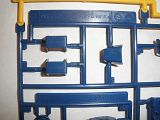
As with all other kits that reuse old runner moldings and add new sections to the runner, this kit is no exception. In the above pic one can see the labeling of the old runner together with the labeling for the entirely new parts.
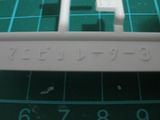
On one of the new runner (Runner L) there exists a portion of the runner with the label “MANIPULATOR 3”, which entirely contains the white hand parts, separated by “runner bridges” (which usually indicates the runner will later have a re-release but with certain added and/or removed parts). From the label, one can assume that Bandai may have already released that part of the runner on other kits prior to this kit.
Manual:
Front page:

Typical MG front page, with the layout later borrowed by the SD GGeneration kits. The top portion shows the series' logo (instead on what faction this unit belongs to, because there are none) and the bottom portion shows the head lineart (which is common to all non-Ver. Ka and OYW kits).
Introductory page:
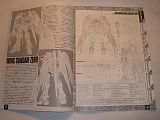
This page shows the unit's whole-body lineart as well as its history. The next page shows the typical list of the various components of the unit.
Parts list:
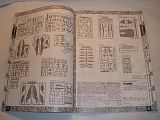
The parts list of the kit, which is one of the things to check out before buying. The typical MG bolt and nut set are noticeably absent.
Building notifications:

The building notifications are located at the top of page 6 of the manual, which is the first page of the manual proper.
Building index:
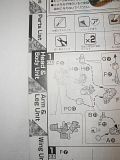
All MG kits feature a “building index”, wherein the manual shows the builder what stage/s is/are to be build on that page.
Parts description:
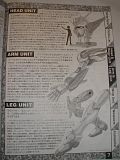
Two pages on the manual are reserved for the descriptions of the unit's major parts (head, arm, leg, wing (if any), weapons) and its serial numbers (if any). The size of the head unit is usually compared to the height of the pilot in this page.
Manual “centerfold”:

This is the manual's “centerfold”, except there is no folded page at the center. These pages usually contain the series' synopsis, unit info, color guide, front and rear view of the kit, weapon set, and the internal frame. The color guide (always) uses GSI Creos' Mr. Color paint series, although a pre-mixed Mr. Color color set may be available for this kit.
Rear centerfold:
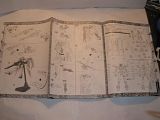
Almost (if not all) MGs feature a rear centerfold, which consists of 4 pages at the fold itself. This page(s) are located just before the decal placement page.
MAIN REVIEW
Body parts
(Note: some foil stickers are applied as per manual instructions. The pilot figure is not assembled into the cockpit. The clear sensor parts located at the arms are not attached due to difficulty of removal. Any large seamlines present on the kit are the result of trimming the underlying male pegs for disassembly preparation, unless stated otherwise.)
Head:
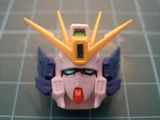
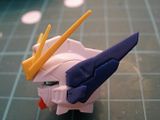
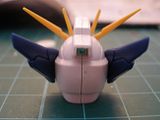
Exactly the same as the Wing Ver. Ka. Typical Gundam head, complete with “ear covers” and the V-fin antenna. In this kit the head is basically made of two halves (standard in those days) and therefore a long seamline runs from the front to the back of the head. The back of the head features a deep panel line that can be mistaken for a wide seamline. The “ear cover” still features the parts taken from its predecessor kit but with new color scheme.
Body:
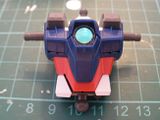

Still exactly the same as the Wing Ver. Ka, except for the color changes. The lower portion of the body consists of a double-ball joint, making the kit to bend forward or backward depending on the pose.
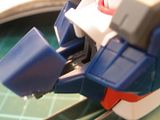

Left to right: The cockpit in open position (without the pilot); the notch that was previously used for the Wing Ver. Ka's transformation (particularly to secure the kit's buster rifle).
Arms:
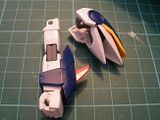
The arms are almost exactly like the Wing Ver. Ka, except the color scheme and the red arm fin. The upper arm assembly is made up of an internal frame, and after the double-jointed elbow is the internal frame-less arm. The wrist can be removed by sliding it away from the arm, and is held secured by the 3-piece blue components. The hands are in all white, but fortunately for some reason the original gray hands are included, so one can make a pair of Wing Ver. Ka hands.
The shoulder armor has an internal frame inside, which is used to have the shoulder armors slide outward for transformation (Wing Ver. Ka) or for the atmospheric re-entry mode (Wing Zero EW). The internal also serves as a some sort of a pre-paint modification for the arms
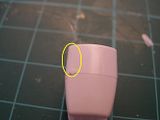
A molding defect on the upper arm. At first glance it looks like it is a panel line, considering that the opposite side of the part also have it. But after checking the 2nd upper arm it has none.
Lower waist:
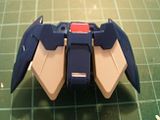
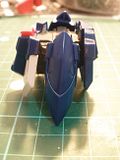
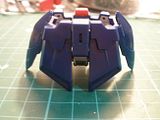
Same as its predecessor, aside from the color scheme. The lower waist is connected by the other end of the double-ball joint, making the whole area poseable. The rear skirt armor can move independently of the whole waist. The ball joints for the ankles cannot move independently, making kneeling poses difficult, if not possible.
Legs:
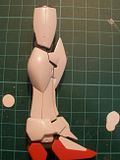
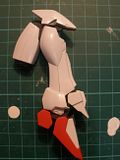

Exact same legs from its predecessor. The legs are pretty slender, which is why no screws are required for this kit. The leg's armor parts are separated into sections, making disassembly and reassembly a lot easier. Aside from that the armor parts does not hinder the movement of the legs itself.
Wings:
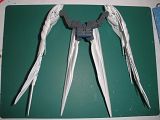
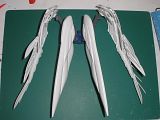
The angelic wings of the Wing Zero EW, which is one of the unit's unique properties and the most distinguishable part of the unit. The main wings are larger than the unit itself that it is used to shield the unit from the extreme heat produced from air friction when performing atmospheric re-entry. All four wings provide thrust for the unit due to the multiple thrusters embedded on the wings (between the “feathers”; similar to the ZGMF-X42S Destiny Gundam). While the rear wings usually do not move (except during atmospheric re-entry when they fold down), the main wings flap as though as it was flying ornithopter-style, it was in fact directing the main wing's thrusters similar to thrust-vectoring, giving the reason why the unit is very maneuverable. The four wing “arms” gives the wings some articulation so that it could be posed in any way. The “arms” for the rear wing also houses the beam saber hilts.
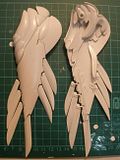

The main wings can do what other Wing Zero EW kits cannot do: expand its upper portion. Expanding the wing requires pushing the rear part inwards then pulling it away from the kit. Pushing it inwards releases the wing's latch so that it cannot expand when not needed. Due to the expansion mechanism of the wing, that portion is seemingly piled in layers of parts and therefore it looks thick. The lower portion of the main wings have the 7 “feathers” attached by small ball joints, making that part very articulated. To replicate the PG version's flexibility, the “feathers” are made from thermoplastic elastomer (TPE, as indicated by the original 2004 manual but not stated here), the same one used on the HG 1:144 GN-001 Gundam Exia's purple shoulder bands. As such it can bend (a little) like the PG version, but because of the material it can easily pop off from the ball joint.
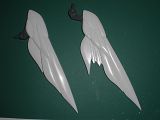
The rear wings are basically made into two halves, meaning it also has a very long seamline running at the back. It also has an expansion mechanism inside, except it is simpler than the main wings.
Weapon systems and included accessories:
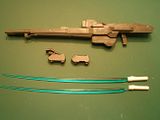
The kit includes 5 weapons: the twin buster rifle, two shoulder machine cannons, and two beam sabers, and a display stand (not shown).
Twin Buster Rifle:
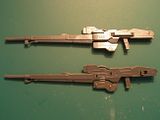
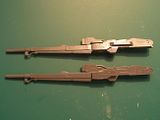
The unit's other unique property. Just like the original TV design, the TBR can be used as a one whole double-barrel rifle, or can be split in two to form two identical single-barrel rifles. The split form can be fired as separate rifles (drawing energy from the unit's main reactor), or together as an attack called “Rolling Buster Rifle” (when surrounded by numerous enemies; this was used once in the TV series, and usually present as a MAP attack (in the EW version) in various SRW games).
Both rifles are constructed the same way: two rifle halves with separate pieces for the sensor, barrel, trigger handle, locking tabs, power cable, and some additional pieces at the bottom. These additional pieces act as additional locking tabs for the combined rifle and are folded up when separated.
Shoulder machine cannons:
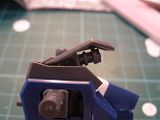
Exactly the same from its predecessor: it consists of four pieces each: cover, casing, cannon body, and the cannon tip. Unlike the one from the Ver. Ka however, the parts are all molded in gray plastic. To expose the cannons, they must be slided forward.
Beam sabers:
This kit includes a pair of beam sabers, usually mounted on the rear wing arms when not in used. The beam saber hilts themselves are molded as a single piece, making the whole beam saber consist of two parts. The beam blades are reused from its predecessor, still molded in clear green and is bent from the mid section to the tip, making the impression of a slashing beam saber.
Display stand:
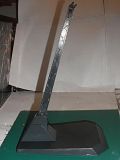
This kit (aside from a handful of others) includes a display stand, which is later reused for the first-production kits of the non-graded 1:100 ZGMF-X42S Destiny Gundam, ZGMF-X20A Strike Freedom Gundam, ZGMF-X19A Infinite Justice Gundam, ORB-01 Oowashi/Shiranui Akatsuki Gundam, and the 1:100 MG GAT-X105+P202QX Strike Gundam + I.W.S.P., GAT-X105E+P202QX Enhanced Strike Gundam + I.W.S.P. (Strike Gundam Unit 3; Lucas O'Donnell custom), and the GAT-X105+AQM/E-X02/03 Sword/Launcher Strike Gundam. Since this type of display stand (particularly the stand's clamp tip) is used in these kits, the clamp tip is included as one of the numerous adapters on all variants of Bandai's Action Base 1 (including the Celestial Being stands included in the first-production and Taiwan's Gunpla Expo 2010 clear color kit of the GN-0000+GNR-010 00 Raiser), making it compatible with these stands. The whole display stand is made up of 5 parts, with a very long flash line running along the stand.
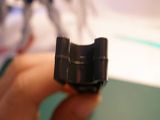
The stand's clamp for attaching the kit to the stand via two pegs located at the kit's chest internal frame (not at the backpack) for added stability. Since a clamp is used (not unlike the other MGs) the kit is not as flimsy as the others. Note the flash line running along the center of the clamp.
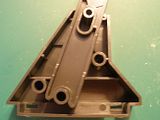

The stand can be either adjusted at 73.6° or at 58.8°, depending on the kit's pose. If the kit is in a regular action pose, the former is usually used, but when it is in the atmospheric re-entry pose then the latter can be used.

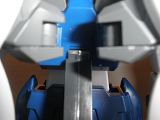
Left: The stand's clamp, which is attached to the rear portion of the backpack (right).
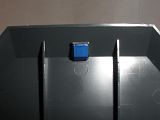
The backpack's cover attached at the bottom of the stand base.
Internal frame:
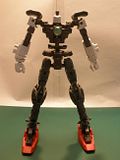
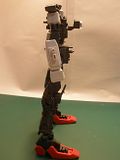

The most-valued trademark of the MG kit line-up. The above pictures are the kit's almost-full internal frame, viewed at the front, right side, and back. Shown protruding at the chest area at side view is the mech's cockpit. Between the chest and the lower waist sections is the double-ball joint used for bending the kit forward or backward. Note the lack of visible piston-rod assemblies (working or not) at the frame.
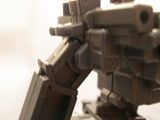
The stand's clamp as attached to the internal frame.
PROFILE PICTURES:
Without the wings:
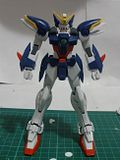
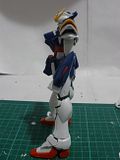
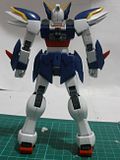
With the wings:
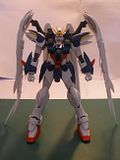

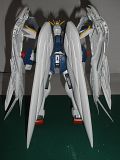
On the stand:

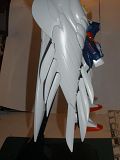
With various attack poses:
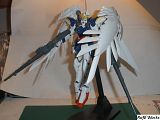
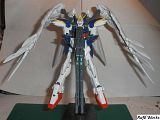
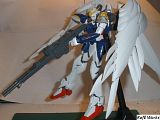
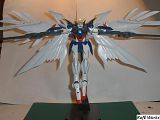
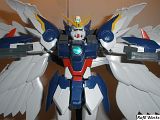
Atmospheric re-entry mode:
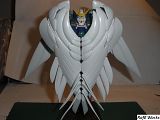

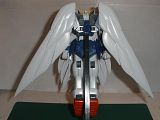
Gunpla 30th Anniversary Clear Parts Campaign:
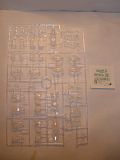
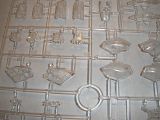
To celebrate Gunpla's 30th anniversary (1980-2010), Bandai included an extra single frame (taken from one of the kit's runners) molded in clear plastic to show the internal frame. That single frame (usually white) is chosen because of it's inclusion of the frame's outer armor parts. In this kit, its the runner B, which includes the whole white outer armor parts for the head, arms, front skirts, and legs.
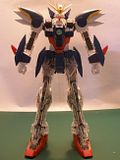
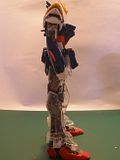
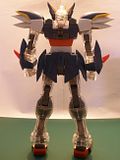
Close-ups:
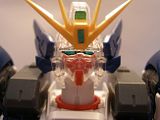

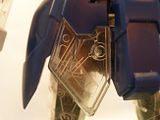
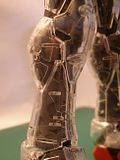
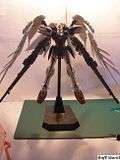

CONCLUSION:
This kit is my 4th incarnation of the Wing Zero EW (1:144 HGFA, SD GGeneration-0, Musha BB-192), and as such I am familiar in some way with this kit. Since I also own an MG Wing Ver. Ka, I knew almost all about this kit's construction. Since those two kits are basically the same, it is possible to switch the backpacks of the two kits, or paint the kit in the other's color scheme (since it also almost share the Ver. Ka's part separations). One problem with this kit is the aforementioned upper arm defect since I know the Ver. Ka didn't have it, although some amount of putty and some sanding will fix it. The defect may be also just present in my copy however. For those who doesn't want the all-white hands, extra parts are included for a white-gray hand just like the Ver. Ka's. With the inclusion of those limited-event parts for the same price, this kit (and the others) totally replaced their original versions (which I intended to buy, except there are no stock left), and its internal frame could be painted the same style as the MG RX-78-2 Ver. 2.0 Mechanical Clear ver. (I wish there are also clear parts for the whole wings just like the 1:144's clear/metal variant). But since I intend to modify and paint this kit those extra clear parts can be very handy later when some unfortunate event happened to their original white parts. Mounting an LED as its search eye is possible, except that it will lose the whole cockpit in process (although in my Wing Ver. Ka's case I have the cockpit modified to hold a watch battery for the LED) but it will retain the outer clear part. The seamline for the lower shoulder fins are lying at the center, meaning that careful sanding is needed to remove the cement and/or putty at the seamline. The lower arms can not be cemented since it will be difficult (if not possible) to make a pre-paint modification, although the seamline can be modified to become a panel line. The skirt armors As for the legs the armor parts are separated very nicely, so no cement is needed (except for the knee joints and the ankle guards). The wings are heavy; the gear-like joint may not last. As for the feathers I may recast them in resin (considering that putty may not attach to TPE), unless I found a more suitable and effective method to deal with the sprue stumps.
OVERALL RATING:
8.0 out of 10 stars
Scale: 1:100
Grade: Master Grade
MG #: 75 (original release)
Series: Shin Kidō Senki Gundam Wing: Endless Waltz (New Mobile Report Gundam Wing: Endless Waltz)
Release date(s):
Original release: October 2004
Clear Parts Campaign Ver.: December 18, 2009
Price: ¥3,990 (both versions; inclusive of tax)
Number of Parts:
Original kit: 319 plastic parts (297 actual parts (151 Polystyrene (PS) + 108 Acrylonitrile butadiene styrene (ABS) + 14 Thermoplastic elastomer (TPE) + 24 Polyethylene (PE)) + 22 unneeded parts) + 1 sheet foil stickers + 1 sheet marking seal + 1 sheet dry-transfer decals
Additional clear parts: 41 clear Polystyrene (PS)
Total Number of Runners: 16 + 1
Polycap Number: PC-126
Plastic Colors: White, Blue, Red, Yellow, Gray, Clear, Clear Green, Black
Weapons and Accessories: Twin buster rifle x1, Beam saber x2, Adjustable stand x1
Kit Gimmicks: internal frame, variable wing design, replication of the mech's various poses as seen in the OVA/movie, compatibility with all variants of Bandai's Action Base 1 (including the clear green and fluorescent green Celestial Being stand) and the stands released with the first production of certain NG 1:100 Gundam SEED Destiny and MG kits, extra clear armor set
HISTORY:
Kit History:
After the release of the much-anticipated MG Wing Gundam Ver. Ka in March 2004, many fans and modelers speculate that in the near future an MG Wing Gundam Zero (EW ver., also known as Wing Gundam Zero Custom to avoid confusion with the TV version), considering that the two are basically the same except for the wings, weapon systems, and the color scheme. Surely enough, it was announced later that the MG version of the Wing Gundam Zero will be released in the near future, together with an optional base stand, just like the MG Ex-S and Aile Strike kits that preceded it. This kit is also notable for starting the trend of releasing a non-Ver. Ka kit based on the Ver. Ka kit itself.
Mecha History:
After designing and (unfinished) building the OZ-00MS Tallgeese, the XXXG-00W0 Wing Gundam Zero was the first mobile suit designed (but not built) by the five former OZ (Organization of Zodiac) scientists (which will build their own Gundam units later based on this mech to be used in Operation Meteor: Doctor J (Wing; from the orbiting colony cluster at Lagrangian point 1), Professor G (Deathscythe; Lagrangian point 2), Doktor S (Heavyarms; Lagrangian point 3), Instructor H (Sandrock; Lagrangian point 4), and Master O (Shenlong; Lagrangian point 5))) to be composed of Gundanium Alloy (a rare and extremely durable metal that can only be created in outer space) as its main armor composition. It was not built due to the MS' two destructive distincts: its twin buster rifle, which can destroy a whole colony in a single shot, and its ZERO System, a cockpit-pilot interface system that directly interfaces the pilot's brain and feeds the pilot real-time tactical data. After sometime on, a grieving Quatre Raberba Winner (pilot of XXXG-01SR Gundam Sandrock) over his father's murder at the hands of OZ's soldiers, stumbled at the blueprints of the Wing Zero and decided to build it using his family's resources as his replacement Gundam. As he first used it, he was severely affected by the unit's ZERO System, causing him to become mentally imbalanced and therefore went on a rampage against OZ and the colonies to avenge his father's death, destroying a natural resource satellite (in other words, an asteroid with incorporated mining facilities) and an evacuated space colony (Colony 06E3) in the process. He was later stopped by Trowa Barton and Heero Yuy, while piloting the OZ-13MSX1 Vayeate and OZ-13MSX2 Mercurius respectively.
Later the unit is taken into possession by OZ and tested its ZERO System (using Heero and (later) Duo Maxwell as test pilots; both were driven mad similar to Quatre due to the system) in hopes that the unit will be incorporated to their line of mobile suits until the Romefeller Foundation's (OZ's parent army) Mobile Doll Chief Engineer Tuberoff sees the Gundam as a threat to his Mobile Dolls and orders his men to have the unit planted with explosives and be destroyed. As his men were evacuating prior to the detonation of the explosives, Zechs Merquise stumbles the Gundam and claimed it, sacrificing his Tallgeese in the process. With Zechs piloting the unit, he then later on encounters Heero with his ZERO System-equipped OZ-13MS Gundam Epyon, built by the Treize Faction leader Treize Khushrenada. They later switched units after their battle during the dissolution of Relena Peacecraft's Sanc Kingdom. This unit remained as Heero's personal unit with his battle with Zechs (now known by his original name Milliardo Peacecraft) and his Gundam Epyon (except in two instances wherein he lend his unit with Trowa and Chang Wufei to solve their respective problems, becoming the only Gundam unit to be used by all five original pilots) during the first Eve War, and later destroyed the last fragment of the Peacemillion-class space battleship Libra during atmospheric entry. After the war, it is stored at the Lunar Base along with the other Gundams with Howard (the co-designer of the Tallgeese and the co-creator of the first Peacemillion-class ship Peacemillion) as its custodian and caretaker until the Gundams (with the exception of Wufei's) are sent to the sun via an abandoned resource satellite for destruction.
Later, due to the war with Dekim Barton's Barton Foundation against the Earth Sphere Unified Nation (ESUN), including with Relena's kidnapping, Heero retrieves the Wing Zero via a special booster system connected to the feet and wings from the satellite thanks from Quatre and his Maganac Corps allies. He later confronted Wufei on Earth orbit and continued their fight after their re-entry in the Earth's atmosphere until the Wing Zero was defeated. The Wing Zero was last seen firing its combined twin buster rifle at the Barton Foundation's Brusell Fortress three times until the fortress' bunker shield and the Wing Zero was destroyed (at the latter's case, due to the effect of the rifle's recoil on a damaged Gundam frame).
PRELIMINARY REVIEW
Box art
Front:

Standard Bandai-style art, depicting the kit in the usual CG form like in other Gundam kits. The MG and the anime logo, as well as the Gunpla 30th Anniversary logo are present at the top right of the box, with the Bandai logo at the lower right of the box. The Clear Parts Campaign logo is at the lower center portion of the box together with the production date (2009 instead of 2004 since this is a special release) at the lower left. The upper box itself measures 32.96cm in height and 24.07cm in length, which is the same for the MG Wing Ver. Ka.
North/South Side:

The art for the north and south side of the box is the same: a simplified version of the front box art, but with a yellow band at the bottom, which seems to indicate what Clear Parts Campaign volume the kit belongs to. The width/depth of the box measures 12.21cm long.
Left Side:


The left side of the box shows the kit's action poses, the kit's markings, the cockpit, the kit as mounted on its display base/stand, and the kit with the exclusive clear parts attached on one side.
Right Side:


The right side of the box features the (typical) front and rear view of the mech (with the painted pilot figure), the opening gimmick of the machine cannons, the internal leg frame, and the wing detail.
Inner cover:

The box's inner cover features the completed kit itself with the stand attached replicating the pose as shown at the box itself. This kit is the second-to-the-last kit to feature an inner cover (before MG #77 RMS-099 Rick Dias Quattro Bagina Custom) aside from the Ver. Ka and OYW kits. The MG logo is also shown at the lower left edge of the cover.
Inner box:

The inner box features a gray stripe at the lower edge, similar to the first-production release of certain NG 1:100 Gundam SEED Destiny kits (the one with the exclusive stands). This stripe indicates that there are additional parts not present in the regular release version, and the width of the stripe indicates the total width of the added sprues.
Underneath the box:

Underneath the kit's box shows the 22 selected MG kits to be released with the exclusive clear parts as part of the campaign's Volume 1 release. The order of release for these kits are different from Ngeekhiong's initial announcement. The box also shows how to “register” the kit to the Club MG website to earn points for use on the Club-specific items.
Kit contents:
Runners:




The kit contains a total of 319 parts crammed in 16 runners (all labeled A-L in usual Bandai style, with the (reusable) beam saber parts labeled as SB4). Some of the runners are basically the same with the MG Wing Ver. Ka, while the other nine runners are brand-new. Runner D has its color changed from white to blue.

As with all other kits that reuse old runner moldings and add new sections to the runner, this kit is no exception. In the above pic one can see the labeling of the old runner together with the labeling for the entirely new parts.

On one of the new runner (Runner L) there exists a portion of the runner with the label “MANIPULATOR 3”, which entirely contains the white hand parts, separated by “runner bridges” (which usually indicates the runner will later have a re-release but with certain added and/or removed parts). From the label, one can assume that Bandai may have already released that part of the runner on other kits prior to this kit.
Manual:
Front page:

Typical MG front page, with the layout later borrowed by the SD GGeneration kits. The top portion shows the series' logo (instead on what faction this unit belongs to, because there are none) and the bottom portion shows the head lineart (which is common to all non-Ver. Ka and OYW kits).
Introductory page:

This page shows the unit's whole-body lineart as well as its history. The next page shows the typical list of the various components of the unit.
Parts list:

The parts list of the kit, which is one of the things to check out before buying. The typical MG bolt and nut set are noticeably absent.
Building notifications:

The building notifications are located at the top of page 6 of the manual, which is the first page of the manual proper.
Building index:

All MG kits feature a “building index”, wherein the manual shows the builder what stage/s is/are to be build on that page.
Parts description:

Two pages on the manual are reserved for the descriptions of the unit's major parts (head, arm, leg, wing (if any), weapons) and its serial numbers (if any). The size of the head unit is usually compared to the height of the pilot in this page.
Manual “centerfold”:

This is the manual's “centerfold”, except there is no folded page at the center. These pages usually contain the series' synopsis, unit info, color guide, front and rear view of the kit, weapon set, and the internal frame. The color guide (always) uses GSI Creos' Mr. Color paint series, although a pre-mixed Mr. Color color set may be available for this kit.
Rear centerfold:

Almost (if not all) MGs feature a rear centerfold, which consists of 4 pages at the fold itself. This page(s) are located just before the decal placement page.
MAIN REVIEW
Body parts
(Note: some foil stickers are applied as per manual instructions. The pilot figure is not assembled into the cockpit. The clear sensor parts located at the arms are not attached due to difficulty of removal. Any large seamlines present on the kit are the result of trimming the underlying male pegs for disassembly preparation, unless stated otherwise.)
Head:



Exactly the same as the Wing Ver. Ka. Typical Gundam head, complete with “ear covers” and the V-fin antenna. In this kit the head is basically made of two halves (standard in those days) and therefore a long seamline runs from the front to the back of the head. The back of the head features a deep panel line that can be mistaken for a wide seamline. The “ear cover” still features the parts taken from its predecessor kit but with new color scheme.
Body:


Still exactly the same as the Wing Ver. Ka, except for the color changes. The lower portion of the body consists of a double-ball joint, making the kit to bend forward or backward depending on the pose.


Left to right: The cockpit in open position (without the pilot); the notch that was previously used for the Wing Ver. Ka's transformation (particularly to secure the kit's buster rifle).
Arms:

The arms are almost exactly like the Wing Ver. Ka, except the color scheme and the red arm fin. The upper arm assembly is made up of an internal frame, and after the double-jointed elbow is the internal frame-less arm. The wrist can be removed by sliding it away from the arm, and is held secured by the 3-piece blue components. The hands are in all white, but fortunately for some reason the original gray hands are included, so one can make a pair of Wing Ver. Ka hands.
The shoulder armor has an internal frame inside, which is used to have the shoulder armors slide outward for transformation (Wing Ver. Ka) or for the atmospheric re-entry mode (Wing Zero EW). The internal also serves as a some sort of a pre-paint modification for the arms

A molding defect on the upper arm. At first glance it looks like it is a panel line, considering that the opposite side of the part also have it. But after checking the 2nd upper arm it has none.
Lower waist:



Same as its predecessor, aside from the color scheme. The lower waist is connected by the other end of the double-ball joint, making the whole area poseable. The rear skirt armor can move independently of the whole waist. The ball joints for the ankles cannot move independently, making kneeling poses difficult, if not possible.
Legs:



Exact same legs from its predecessor. The legs are pretty slender, which is why no screws are required for this kit. The leg's armor parts are separated into sections, making disassembly and reassembly a lot easier. Aside from that the armor parts does not hinder the movement of the legs itself.
Wings:


The angelic wings of the Wing Zero EW, which is one of the unit's unique properties and the most distinguishable part of the unit. The main wings are larger than the unit itself that it is used to shield the unit from the extreme heat produced from air friction when performing atmospheric re-entry. All four wings provide thrust for the unit due to the multiple thrusters embedded on the wings (between the “feathers”; similar to the ZGMF-X42S Destiny Gundam). While the rear wings usually do not move (except during atmospheric re-entry when they fold down), the main wings flap as though as it was flying ornithopter-style, it was in fact directing the main wing's thrusters similar to thrust-vectoring, giving the reason why the unit is very maneuverable. The four wing “arms” gives the wings some articulation so that it could be posed in any way. The “arms” for the rear wing also houses the beam saber hilts.


The main wings can do what other Wing Zero EW kits cannot do: expand its upper portion. Expanding the wing requires pushing the rear part inwards then pulling it away from the kit. Pushing it inwards releases the wing's latch so that it cannot expand when not needed. Due to the expansion mechanism of the wing, that portion is seemingly piled in layers of parts and therefore it looks thick. The lower portion of the main wings have the 7 “feathers” attached by small ball joints, making that part very articulated. To replicate the PG version's flexibility, the “feathers” are made from thermoplastic elastomer (TPE, as indicated by the original 2004 manual but not stated here), the same one used on the HG 1:144 GN-001 Gundam Exia's purple shoulder bands. As such it can bend (a little) like the PG version, but because of the material it can easily pop off from the ball joint.

The rear wings are basically made into two halves, meaning it also has a very long seamline running at the back. It also has an expansion mechanism inside, except it is simpler than the main wings.
Weapon systems and included accessories:

The kit includes 5 weapons: the twin buster rifle, two shoulder machine cannons, and two beam sabers, and a display stand (not shown).
Twin Buster Rifle:


The unit's other unique property. Just like the original TV design, the TBR can be used as a one whole double-barrel rifle, or can be split in two to form two identical single-barrel rifles. The split form can be fired as separate rifles (drawing energy from the unit's main reactor), or together as an attack called “Rolling Buster Rifle” (when surrounded by numerous enemies; this was used once in the TV series, and usually present as a MAP attack (in the EW version) in various SRW games).
Both rifles are constructed the same way: two rifle halves with separate pieces for the sensor, barrel, trigger handle, locking tabs, power cable, and some additional pieces at the bottom. These additional pieces act as additional locking tabs for the combined rifle and are folded up when separated.
Shoulder machine cannons:

Exactly the same from its predecessor: it consists of four pieces each: cover, casing, cannon body, and the cannon tip. Unlike the one from the Ver. Ka however, the parts are all molded in gray plastic. To expose the cannons, they must be slided forward.
Beam sabers:
This kit includes a pair of beam sabers, usually mounted on the rear wing arms when not in used. The beam saber hilts themselves are molded as a single piece, making the whole beam saber consist of two parts. The beam blades are reused from its predecessor, still molded in clear green and is bent from the mid section to the tip, making the impression of a slashing beam saber.
Display stand:

This kit (aside from a handful of others) includes a display stand, which is later reused for the first-production kits of the non-graded 1:100 ZGMF-X42S Destiny Gundam, ZGMF-X20A Strike Freedom Gundam, ZGMF-X19A Infinite Justice Gundam, ORB-01 Oowashi/Shiranui Akatsuki Gundam, and the 1:100 MG GAT-X105+P202QX Strike Gundam + I.W.S.P., GAT-X105E+P202QX Enhanced Strike Gundam + I.W.S.P. (Strike Gundam Unit 3; Lucas O'Donnell custom), and the GAT-X105+AQM/E-X02/03 Sword/Launcher Strike Gundam. Since this type of display stand (particularly the stand's clamp tip) is used in these kits, the clamp tip is included as one of the numerous adapters on all variants of Bandai's Action Base 1 (including the Celestial Being stands included in the first-production and Taiwan's Gunpla Expo 2010 clear color kit of the GN-0000+GNR-010 00 Raiser), making it compatible with these stands. The whole display stand is made up of 5 parts, with a very long flash line running along the stand.

The stand's clamp for attaching the kit to the stand via two pegs located at the kit's chest internal frame (not at the backpack) for added stability. Since a clamp is used (not unlike the other MGs) the kit is not as flimsy as the others. Note the flash line running along the center of the clamp.


The stand can be either adjusted at 73.6° or at 58.8°, depending on the kit's pose. If the kit is in a regular action pose, the former is usually used, but when it is in the atmospheric re-entry pose then the latter can be used.


Left: The stand's clamp, which is attached to the rear portion of the backpack (right).

The backpack's cover attached at the bottom of the stand base.
Internal frame:



The most-valued trademark of the MG kit line-up. The above pictures are the kit's almost-full internal frame, viewed at the front, right side, and back. Shown protruding at the chest area at side view is the mech's cockpit. Between the chest and the lower waist sections is the double-ball joint used for bending the kit forward or backward. Note the lack of visible piston-rod assemblies (working or not) at the frame.

The stand's clamp as attached to the internal frame.
PROFILE PICTURES:
Without the wings:



With the wings:



On the stand:


With various attack poses:





Atmospheric re-entry mode:



Gunpla 30th Anniversary Clear Parts Campaign:


To celebrate Gunpla's 30th anniversary (1980-2010), Bandai included an extra single frame (taken from one of the kit's runners) molded in clear plastic to show the internal frame. That single frame (usually white) is chosen because of it's inclusion of the frame's outer armor parts. In this kit, its the runner B, which includes the whole white outer armor parts for the head, arms, front skirts, and legs.



Close-ups:






CONCLUSION:
This kit is my 4th incarnation of the Wing Zero EW (1:144 HGFA, SD GGeneration-0, Musha BB-192), and as such I am familiar in some way with this kit. Since I also own an MG Wing Ver. Ka, I knew almost all about this kit's construction. Since those two kits are basically the same, it is possible to switch the backpacks of the two kits, or paint the kit in the other's color scheme (since it also almost share the Ver. Ka's part separations). One problem with this kit is the aforementioned upper arm defect since I know the Ver. Ka didn't have it, although some amount of putty and some sanding will fix it. The defect may be also just present in my copy however. For those who doesn't want the all-white hands, extra parts are included for a white-gray hand just like the Ver. Ka's. With the inclusion of those limited-event parts for the same price, this kit (and the others) totally replaced their original versions (which I intended to buy, except there are no stock left), and its internal frame could be painted the same style as the MG RX-78-2 Ver. 2.0 Mechanical Clear ver. (I wish there are also clear parts for the whole wings just like the 1:144's clear/metal variant). But since I intend to modify and paint this kit those extra clear parts can be very handy later when some unfortunate event happened to their original white parts. Mounting an LED as its search eye is possible, except that it will lose the whole cockpit in process (although in my Wing Ver. Ka's case I have the cockpit modified to hold a watch battery for the LED) but it will retain the outer clear part. The seamline for the lower shoulder fins are lying at the center, meaning that careful sanding is needed to remove the cement and/or putty at the seamline. The lower arms can not be cemented since it will be difficult (if not possible) to make a pre-paint modification, although the seamline can be modified to become a panel line. The skirt armors As for the legs the armor parts are separated very nicely, so no cement is needed (except for the knee joints and the ankle guards). The wings are heavy; the gear-like joint may not last. As for the feathers I may recast them in resin (considering that putty may not attach to TPE), unless I found a more suitable and effective method to deal with the sprue stumps.
OVERALL RATING:
8.0 out of 10 stars





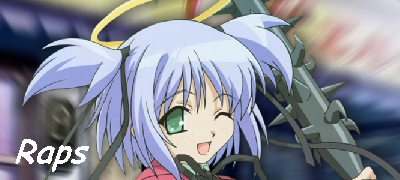




 keeping the site active as a place to dump info for easier backtracking.
keeping the site active as a place to dump info for easier backtracking. 